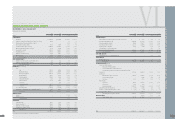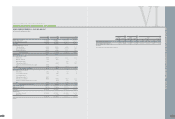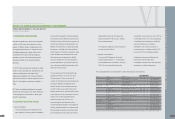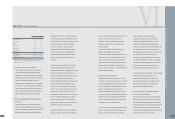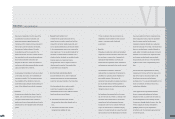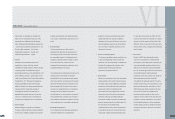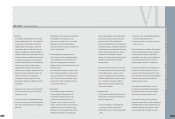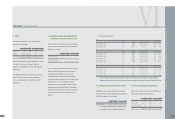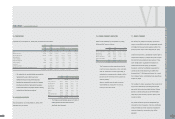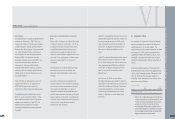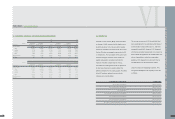HTC 2007 Annual Report Download - page 87
Download and view the complete annual report
Please find page 87 of the 2007 HTC annual report below. You can navigate through the pages in the report by either clicking on the pages listed below, or by using the keyword search tool below to find specific information within the annual report.
AN OVERVIEW OFTHE COMPANY'S FINANCIAL STATUS
169168
judgment, and any known factors that would
significantly affect the accruals. In addition,
depending on the nature of relevant events, the
accrued marketing expenses are accounted for
as an increase in marketing expenses or as a
decrease in revenues.
> R
e
s
e
rv
e
f
or W
a
rr
a
n
t
y Exp
e
ns
e
s
The Company provides warranty service for one
to two years depending on the contract with
customers. The warranty liability is estimated on
the basis of management's evaluation of the
products under warranty, past warranty
experience, and pertinent factors.
> Bonds P
a
y
a
b
l
e
Bonds are issued at face value and recorded as
bonds payable. Each month's interest expense
is booked at face value multiplied by the stated
interest rate. For bonds sold under repurchase
agreements, interest is calculated at the
repurchase value and recognized as interest
expense by period. The direct and necessary
expenses of issuing convertible bonds are
recorded as issuance expenses and amortized
from the issuance date to the maturity date. On
the conversion of convertible bonds,
unamortized issue costs, interest expense that
is accreted to the date of conversion but need
not be paid, recognized interest premium, and
the par value of the bonds are written off. The
common stock should be valued at the carrying
amount net of the amounts written off, and the
difference of this net amount from the par value
of the common stock is recognized as additional
paid-in capital.
> P
e
ns
i
on P
l
a
n
Under the ROC Labor Standards Law (the
"Law"), which provides for a defined benefit
pension plan, the Company has a pension plan
covering all eligible employees. Based on the
Statement of Financial Accounting Standards
No. 18 - "Accounting for Pensions" issued by the
Accounting Research and Development
Foundation of the ROC, pension cost under the
defined benefit pension plan should be
calculated by the actuarial method. The Labor
Pension Act (the "Act), which provides for a new
defined contribution plan, took effect on July 1,
2005. Employees already covered by the Law
can choose to remain to be subject to the
pension mechanism under the Law or to be
subject to the Act. Under the Act, the rate of an
employer's monthly contribution to the pension
fund should be at least 6% of the employee's
monthly wages, and the contribution should be
recognized as pension expense in the income
statement.
VI
Depreciation is calculated on a straight-line
basis over the estimated service lives of the
assets plus one additional year for salvage
value: buildings(including auxiliary equipments)
- 3 to 50 years; machinery and equipment - 3 to
5 years; office equipment - 3 to 5 years;
transportation equipment - 5 years; and
leasehold improvements - 3 years.
> Goodw
ill
Goodwill is the consideration paid for an
acquisition in excess of the fair value of
identifiable net assets acquired. Before January
1, 2006, goodwill was amortized using the
straight-line method over the estimated life of 10
years. Effective January 1, 2006, based on the
newly revised Statement of Financial Accounting
Standards No. 25 - "Business Combinations -
Accounting Treatment under the Purchase
Method," goodwill is no longer amortized and is
instead tested for impairment annually. If
circumstances show that the fair value of
goodwill has become lower than its carrying
amount, an impairment loss is recognized. A
reversal of this impairment loss is not allowed.
> D
e
f
e
rr
e
d Ch
a
rg
e
s
Deferred charges are telephone installation
charges, computer software costs and deferred
license fees. Installation charges and computer
software are amortized on a straight-line basis
over 3 years, and deferred license fees, over 10
years.
> Ass
e
t
Imp
a
i
rm
e
n
t
If the recoverable amount of an asset is
estimated to be less than its carrying amount,
the carrying amount of the asset is reduced to
its recoverable amount. An impairment loss is
charged to earnings unless the asset is carried
at a revalued amount, in which case the
impairment loss is treated as a deduction to the
unrealized revaluation increment.
If an impairment loss subsequently reverses, the
carrying amount of the asset is increased
accordingly, but the increased carrying amount
may not exceed the carrying amount that would
have been determined had no impairment loss
been recognized for the asset in prior years. A
reversal of an impairment loss is recognized in
earnings, unless the asset is carried at a
revalued amount, in which case the reversal of
the impairment loss is treated as an increase in
the unrealized revaluation increment. A reversal
of an impairment loss on goodwill is disallowed.
> A
cc
ru
e
d M
a
r
k
e
t
i
ng Exp
e
ns
e
s
The Company accrues marketing expenses on
the basis of agreements, management's
FINANCEI CONSOLIDATED REPORT
l




